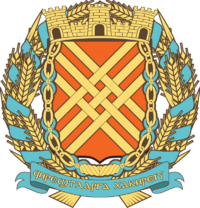Mannatiua Revolutionary Defense Forces
| Vurthungria Revolutionary Defense Forces | |
|---|---|
| Ganasdsåmhårrhen o'Fortungirweg (Vurthungrian) Þéodhare Vorþongerisc (Innan) Gruppu di Difesa Rivoluzionariu Fortongrolu (Escara) | |
| Motto | "In the name of peace, liberty, and universal solidarity, we march." |
| Founded | 19 February, 1939 |
| Current form | 31 January, 1981 |
| Service branches | |
| Headquarters | Bitte Central Armory, New Haim |
| Leadership | |
| Commander-in-chief | |
| Chair of the General Staff | General Cenánbaragh Yarpain |
| Personnel | |
| Military age | 18 for voluntary service |
| Conscription | No Peacetime Conscription |
| Active personnel | 62,813 |
| Reserve personnel | 53,236 |
| Deployed personnel | 38,977 |
| Expenditure | |
| Budget | 5.3 Billion IRM |
| Percent of GDP | 1.38% |
| Industry | |
| Domestic suppliers | CDV Group FAE CNYE Group |
| Foreign suppliers | |
| Related articles | |
| History | Military History of Vurthungria List of Conflicts involving Vurthungira |
| Ranks | Military ranks of Vurthungria |
The Vurthungria Revolutionary Defense Forces is the military of the Vurthungrian Free Association of Communes, consisting of the Black Army, Coastal Defence Forces, Air Forces, Strategic Support Services, and the Republican Guard. The Revolutionary Defense Bureau and its Commissioner (Dennel Beámm since 2008) is the civilian administration of the military, while the General Staff and its Chairman (General Cenánbaragh Yarpain since 2019) are the chief coordinating officers in the military itself. The commander-in-chief is the First Citizen, though in practice they often coordinate military policy with the First Commissar due to war powers generally being held by the legislature in Vurthungria.
History
Origins
The origins of the Vurthungria Revolutionary Defense Forces is in the first iterations of the Black Army of Revolutionary Vurthungria, which first assembled during the Officers' War. It was organized from a number of disparate armed leftist movements in Vurthungria, including the Internationalist Proletarian Front of the Vordons (PFV) led by Dauben Bitt and his clique of military deserters, the Mennemist Vurthungrian Popular Will Army (VPWA) under Cutagilse Sophnen, and a loose coalition of local and ethnic defense militias and armed Anarchist groups under the banner of the Free Peoples Defense League (FPDL), led in exile by Tenemore Tarradh through his proxy and common-law wife Averilde Fauller. Tarradh was in hiding in Castelana at the time of the Officers' Coup, due to his part to then-suspected ties to the deaths of King Edel IX in 1921. They would return to Vurthungria by rail upon the news of the Officers' Coup being initiated, and would attempt to form a united front with the rebelling Vurthungrian National Army (VNA) to depose the remaining royalist elements of the country, and perhaps expand into historically Vurthungrian lands.
Upon Tarradh's return, he used his intellectual clout among Vurthungrians to amass the major leftist movements into a singular coaliton, and alongside sympathetic nationalists, founded the Vurthungrian Peoples' Liberation Army (VPLA) in the town of Merefin on 20 May, 1939, which is now known as Defense Forces Day in present-day Vurthungria. Bitt would become the de facto supreme commander of the VPLA forces, while Tarradh focused on accruing political capital for their coalition as their public leader. After the Vurthungrian Civil War broke out in 1943 after numerous confrontations between the VNA and VPLA, Tarradh's coalition became largely known as the "Black Army" abroad, though was still officially regarded by its pre-war title until 1945, following the Little Terror which largely saw a purge of the Mennemist wings of the group.
Following the close of hostilities and the adoption of the Vurthungrian Constitution in 1947, the Black Army was reformed as the Vurthungria Revolutionary Defense Forces, and would be officially barred from participating in wars of aggression.
Constitutional Era (1947-1991)
The Modern VRDF (1991-Present)
Organization
The Vurthungria Revolutionary Defense Forces are commanded by the General Defense Commission, composed of the top senior officers of each of the branches of the VRDF. The General Defense Commission is in turn led by the GDC Executive Commissioner, who is appointed by the Executive Commission and overseen by the First Citizen, who is commander-in-chief of the VRDF, though the First Commissar is sometimes consulted, as war powers are vested in the national legislature.
The VRDF is composed of five service branches: the Black Army, which comprises the Vurthungrian ground forces; Coastal Defense Forces, which engages in naval activities in Vurthungrian territorial waters; Air Forces, which oversees aerospace defense and the nation's orbital assets; Strategic Support Services, comprised of engineering, medical support, cyberdefense, reconnaissance, and other peripheral corps and services; and the Revolutionary Guard, which oversees special forces operations, intelligence services, and the protection of public places and figures.
